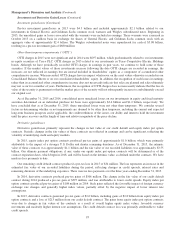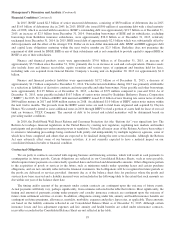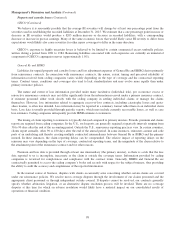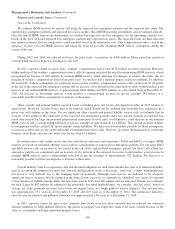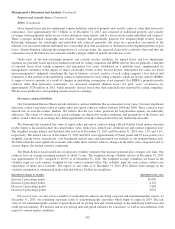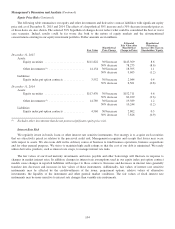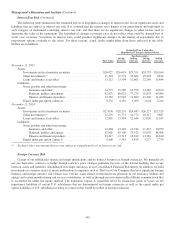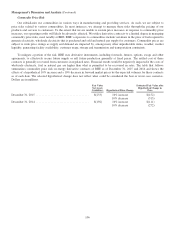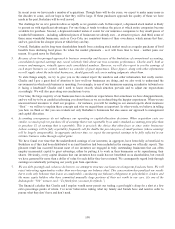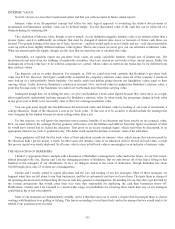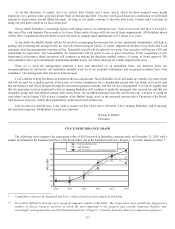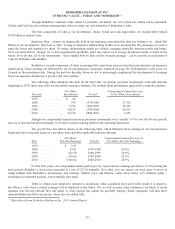Berkshire Hathaway 2015 Annual Report Download - page 105
Download and view the complete annual report
Please find page 105 of the 2015 Berkshire Hathaway annual report below. You can navigate through the pages in the report by either clicking on the pages listed below, or by using the keyword search tool below to find specific information within the annual report.Management’s Discussion and Analysis (Continued)
Other Critical Accounting Policies
We record deferred charges with respect to liabilities assumed under retroactive reinsurance contracts. At the inception of
these contracts, the deferred charges represent the excess, if any, of the estimated ultimate liability for unpaid losses over the
consideration received. Deferred charges are amortized using the interest method over an estimate of the ultimate claim
payment period with the periodic amortization reflected in earnings as a component of losses and loss adjustment expenses.
Deferred charge balances are adjusted periodically to reflect new projections of the amount and timing of remaining loss
payments. Adjustments to deferred charge balances resulting from changes to these assumptions are determined retrospectively
from the inception of the contract. Unamortized deferred charges were approximately $7.7 billion at December 31, 2015.
Significant changes in the estimated amount and the timing of payments of unpaid losses may have a significant effect on
unamortized deferred charges and the amount of periodic amortization.
Our Consolidated Balance Sheet includes goodwill of acquired businesses of $62.7 billion. We evaluate goodwill for
impairment at least annually and we conducted our most recent annual review during the fourth quarter of 2015. Our review
includes determining the estimated fair values of our reporting units. There are several methods of estimating a reporting unit’s
fair value, including market quotations, underlying asset and liability fair value determinations and other valuation techniques,
such as discounted projected future net earnings or net cash flows and multiples of earnings. We primarily use discounted
projected future earnings or cash flow methods. The key assumptions and inputs used in such methods may include forecasting
revenues and expenses, operating cash flows and capital expenditures, as well as an appropriate discount rate and other inputs.
A significant amount of judgment is required in estimating the fair value of a reporting unit and in performing goodwill
impairment tests. Due to the inherent uncertainty in forecasting cash flows and earnings, actual results may vary significantly
from the forecasts. If the carrying amount of a reporting unit, including goodwill, exceeds the estimated fair value, then, as
required by GAAP, we estimate the fair values of the identifiable assets and liabilities of the reporting unit. The excess of the
estimated fair value of the reporting unit over the estimated fair value of its net assets establishes the implied value of goodwill.
The excess of the recorded amount of goodwill over the implied value is charged to earnings as an impairment loss.
Market Risk Disclosures
Our Consolidated Balance Sheets include substantial amounts of assets and liabilities whose fair values are subject to
market risks. Our significant market risks are primarily associated with equity prices, interest rates, foreign currency exchange
rates and commodity prices. The fair values of our investment portfolios and equity index put option contracts remain subject to
considerable volatility. The following sections address the significant market risks associated with our business activities.
Equity Price Risk
Historically, we have maintained large amounts of invested assets in exchange traded equity securities. Strategically, we
strive to invest in businesses that possess excellent economics, with able and honest management and at sensible prices and
prefer to invest a meaningful amount in each investee. Consequently, equity investments are concentrated in relatively few
issuers. At December 31, 2015, approximately 59% of the total fair value of equity investments was concentrated within four
companies.
We often hold equity investments for long periods of time so we are not troubled by short-term price volatility with respect
to our investments provided that the underlying business, economic and management characteristics of the investees remain
favorable. We strive to maintain significant levels of shareholder capital and ample liquidity to provide a margin of safety
against short-term price volatility.
Market prices for equity securities are subject to fluctuation and consequently the amount realized in the subsequent sale of
an investment may significantly differ from the reported market value. Fluctuation in the market price of a security may result
from perceived changes in the underlying economic characteristics of the investee, the relative price of alternative investments
and general market conditions.
We are also subject to equity price risk with respect to our equity index put option contracts. While our ultimate liability
with respect to these contracts is determined from the movement of the underlying stock index between the contract inception
date and expiration date, fair values of these contracts are also affected by changes in other factors such as interest rates,
expected dividend rates and the remaining duration of the contract.
103


